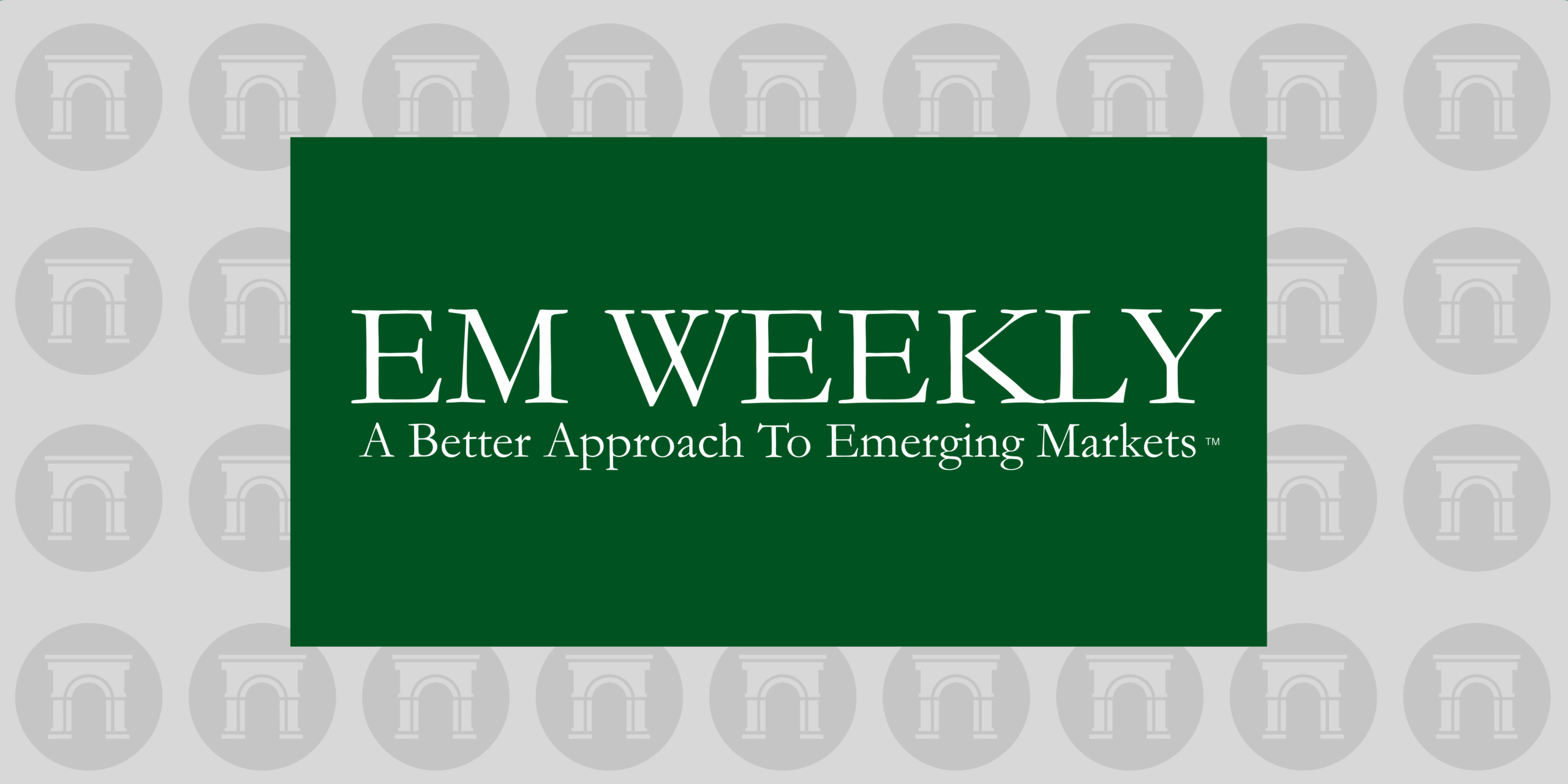Contents
Market Overview
Macro Update
This past week proved consequential for global markets, marked by a confluence of developments across U.S. monetary policy, trade negotiations, macroeconomic data releases, and corporate earnings.
At the center of market focus was the Federal Reserve’s decision to hold its target range steady at 4.25%–4.50%, reaffirming its data-dependent stance amid persistent inflationary pressures and ongoing labor market strength. Notably, two dissenting votes by Board Governors were made in favor of a rate cut—the first time this has happened in over 30 years. With forward guidance kept intentionally opaque due to heightened economic uncertainty, political pressure intensified. President Donald Trump sharply criticized both the Fed’s decision and Fed Chair Jerome Powell, reiterating calls for significantly lower interest rates.
Labor market data later in the week appeared to validate the dissenting voters concerns about economic softness. The July employment report delivered a notable downside surprise—just 73,000 jobs were added vs. the 104,000 expected. However, the more striking development was the downward revision to the prior two months, which collectively erased 258,000 previously reported jobs. This revision alters the perceived trajectory of labor market momentum: the three-month average payroll gain has now dropped from 150,000 to just 35,000. The unemployment rate rose to 4.2%, aligning with consensus estimates.
Manufacturing indicators offered a mixed picture. The final July manufacturing PMI improved marginally to 49.8 from the earlier flash estimate of 49.5, yet the ISM Manufacturing Index signaled the fastest pace of contraction in U.S. factory activity in nine months. In contrast, consumer sentiment rose, with the final July University of Michigan index reaching a five-month high—buoyed in part by strong equity performance. Still, the prevailing macro data likely dilutes its relevance to market participants.
On the growth front, second-quarter GDP expanded at a 3.0% quarter-over-quarter pace, exceeding expectations largely due to reduced imports after earlier inventory accumulation. The Fed’s preferred inflation gauge, core PCE, rose 0.3% month-over-month and 2.8% year-over-year. Consumer spending showed signs of deceleration, while the Conference Board’s Consumer Confidence Index improved modestly but remains below its late-2024 levels. Weekly jobless claims were stable at 218,000—slightly under expectations.
In terms of trade policy, on August 1st, the deadline set for progress on several bilateral trade fronts, the Trump Administration unveiled new “reciprocal” tariffs on more than 60 countries, including Canada, India and Taiwan that face rates of 35%, 25% and 20%, respectively. Earlier in the week, an agreement was reached with South Korea, centered on a 15% tariff structure that closely mirrors the deal with Japan. Separately, the U.S. announced a sharp increase in tariffs on Brazilian exports—from 10% to 50%—though exemptions covering around 40% of affected goods may limit the net impact. The U.S. introduced new tariffs on select copper products as well, but widespread exemptions triggered a decline in copper futures.
Against this complicated and fluid backdrop, financial markets experienced a volatile week. Having reached new highs earlier in the week, the major global equity indices sold off aggressively on Friday on the back of tariff headlines and labor data. The S&P and NASDAQ were around 2.0% lower on the day, breaking below 20-day moving averages. Treasury yields plunged lower as traders reconfigured again their expectations about Fed interest rate cuts and the UST curve steepened. The 2, 10, and 30-year yields finished the week significantly lower, at around 3.75%, 4.25%, and 4.80%, respectively. The U.S. dollar gave back around half of its weekly gains but finished slightly higher at around 99 on the DXY. Oil exhibited a similar dynamic, giving up most gains and finishing the week in the low 70s per barrel (Brent). Gold surged back toward its recent high, not surprisingly amid the general market sell-off.
In Europe, President Trump and European Commission President Ursula von der Leyen met in Scotland and reached a framework aimed at avoiding broader transatlantic trade tensions. The agreement includes a 15% tariff on most EU goods, alongside increased commitments on U.S. energy and defense procurement. While the framework was presented as a pragmatic compromise, French and German leaders publicly criticized the agreement and warned of negative consequences for the bloc. Meanwhile, the U.S. extended its existing tariff framework with China and granted Mexico a 90-day reprieve from higher rates to allow further negotiations.
Globally, central banks continued to move in different directions. The Bank of Japan held its key rate at 0.5%, with Governor Kazuo Ueda signaling a willingness to act should inflation expectations firm further. Chile’s Central Bank resumed its easing cycle with a 25bps cut to 4.75%. Brazil’s Central Bank left its policy rate unchanged at 15%, as anticipated, and Colombia surprised markets by holding its key rate at 9.25% in a divided vote.
Eurozone GDP data came in slightly above expectations at 0.1% quarter-over-quarter and 1.4% year-over-year, supported by growth in France and Spain that offset continued weakness in Germany and Italy. Trade-related uncertainty and subdued investment continued to weigh on the region’s larger economies.
On the corporate front, Microsoft and Meta both reported stronger than expected earnings, driven in part by growth in artificial intelligence-related revenue. Both companies indicated they would continue increasing capital investment in AI infrastructure. Apple also reported much stronger quarterly results than expected, attributed in part to tariffs as consumers rushed to make purchases ahead of levies coming into effect.
In the geopolitical arena, Russia expanded its military campaign in eastern Ukraine, capturing a town in the Donetsk region. On Friday, President Trump ordered two nuclear submarines to the region citing the Russia threat. In Southeast Asia, a ceasefire was announced between Thailand and Cambodia following several days of border conflict; President Trump publicly claimed credit for helping to de-escalate the situation through trade diplomacy. Separately, leaders from France, the UK, and Canada pledged support for recognizing a Palestinian state by September, contingent on a ceasefire in Gaza and new elections absent Hamas participation.
EM Credit Update
Emerging market hard currency sovereign debt delivered a return of 0.45% this week, supported by good risk appetite, especially earlier in the week. Investment grade marginally outperformed high yield, returning 0.46% versus 0.44%, as spreads tightened by 3bps at the index level. The compression was driven investment grade as high-yield spreads widened 12bps this week.
Regionally, Africa and Central Europe led performance, with notable strength in Senegal, Gabon, and Ukraine. Senegal extended its rally on optimism around renewed IMF engagement. Gabon benefitted from strong technical support and broader demand for high-beta African names. Ukraine also posted a sharp move higher on renewed geopolitical optimism, though part of that rally faded later in the week. In contrast, Venezuela underperformed, reversing recent gains as markets reassessed overly optimistic expectations around sanctions relief. The ruling party’s sweep in local elections has consolidated political power, dampening hopes for near-term debt restructuring.
Local currency debt declined 1.22% as the U.S. dollar strengthened through Thursday. Euro-linked EM currencies such as the Polish zloty and Czech koruna gave back prior gains, while Colombia’s local bonds continued to lag amid unresolved fiscal uncertainty. Chile was also among the week’s weaker performers, weighed down by renewed copper price volatility following tariff-related developments. Peru and Uruguay were the only local markets to finish the week flat to marginally positive.
EM corporate bonds posted a modest gain of 0.25%, with investment grade and high yield performing largely in line. Spreads tightened by 7bps, and returns were supported by longer-duration assets, with the 10-year-plus bucket returning 0.57%. African corporates led regionally, with strong contributions from Morocco, Nigeria, and South Africa.
Primary issuance remained light, with just seven deals pricing. The highlight came early in the week, as Mexico issued a landmark $12 billion in pre-capitalized securities (P-Caps), structured as senior unsecured sovereign obligations. Proceeds are earmarked to support Pemex through securities lending arrangements. The notes priced at T+170bps with a weighted average life of 3.58 years and will amortize through 2030.
The Week Ahead
Markets will continue to digest the tariff announcements and the likely future stance of the Federal Reserve. Beyond that, the Bank of England is expected to lower interest rates by 25bps; additionally, central banks in Romania, Mexico, the Czech Republic, and India will be making their own rate decisions. In the U.S., key data releases include initial jobless claims, wholesale inventories, trade data, ISM services, services PMI, factory orders, and durable goods. The Senate will also enter its August recess, which lasts through September 1ST. In Europe, the eurozone will publish retail sales and services PMI, while Germany will release industrial production and factory orders data. Further east, Poland’s parliament is set to swear in Karol Nawrocki as president and Türkiye will publish July CPI data. China will report on trade, foreign reserves, and services PMI. In the commodities sector, the OPEC+ monthly meeting will decide on September production levels, with expectations of another significant output increase. Chile, one of the world’s major copper producers, will release data on July copper exports.
Fixed Income
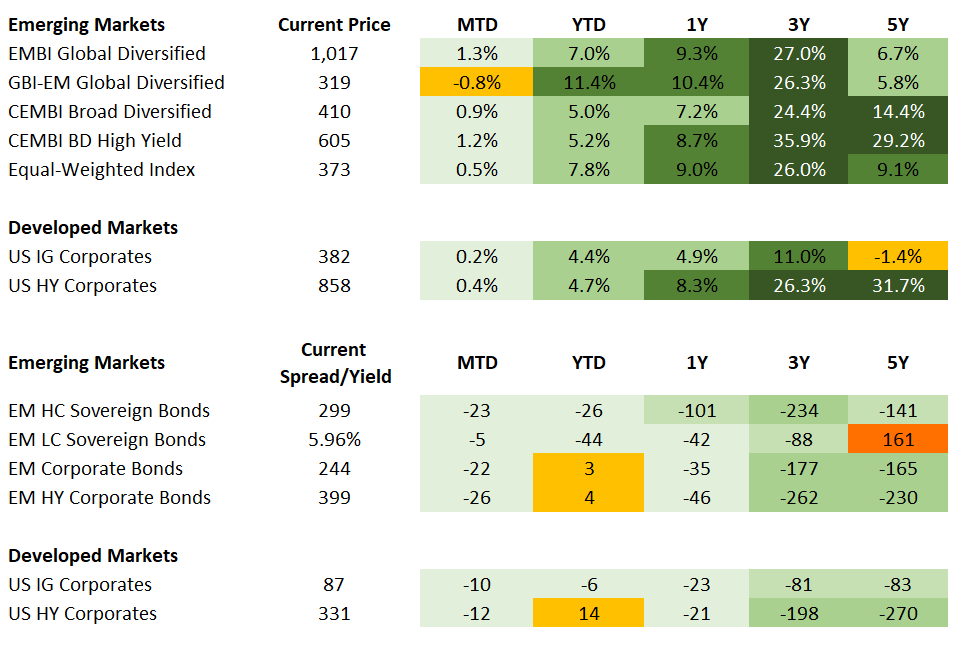
Equities
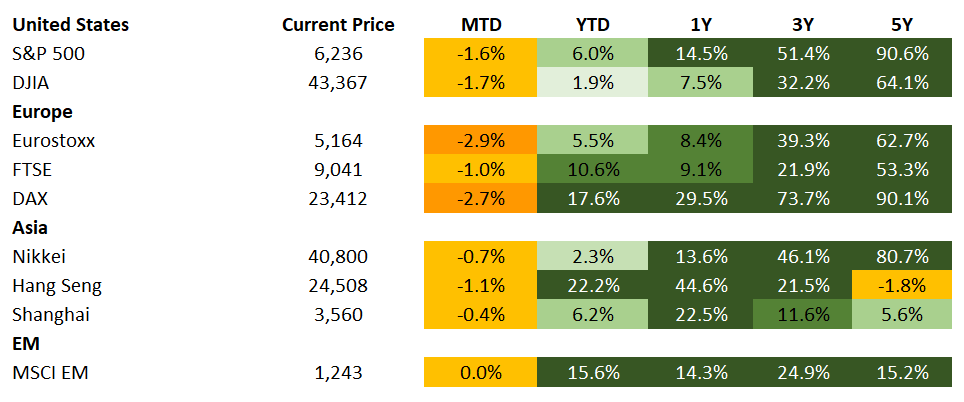
Commodities

Source for data tables: Bloomberg, JPMorgan, Gramercy. EM Fixed Income is represented by the following JPMorgan Indicies: EMBI Global, GBI-EM Global Diversified, CEMBI Broad Diversified and CEMBI Broad High Yield. DM Fixed Income is represented by the JPMorgan JULI Total Return Index and Domestic High Yield Index. Fixed Income, Equity and Commodity data is as of August 1, 2025 (mid-day).
Highlights
China’s Politburo Meeting Uneventful Amid Resilient Data
Event: U.S The Politburo meeting underscored clear determination to achieve this year’s 5% of GDP growth target albeit with limited near-term step-up in stimulus amid still resilient economic data. Less emphasis was placed on monetary and fiscal easing with an incremental shift in attention to services-oriented consumption with a dedicated new PBoC relending tool and childcare subsidy program. Property sector support remained concentrated on urban renewal. U.S.-China trade talks in Stockholm showed promise for a 90-day extension of the current August 15th deadline and optimism for a Trump-Xi meeting later in the year. Amid the current tariff truce, the IMF lifted its 2025 forecast for China’s growth by 80bps to 4.8% (10bps above market consensus).
Gramercy Comment: The meeting was largely in line with expectations although underwhelmed on the margin with respect to potential for greater clarity on President Xi Jinping’s renewed focus on over-capacity and supply-side reform which ignited animal spirits and pushed equity prices and bond yields higher over the past month. Removal of language in reference to interest rate and RRR cuts suggests lower likelihood for monetary policy easing in the near-term while we expect gradual continuation of anti-involution or supply-side efforts, helping to moderately lift prices in select sectors. Our base case is that the trade truce holds, although we do not rule out surprises. In the event of re-escalation or deterioration in activity data, Chinese authorities will react proportionately with stronger stimulus efforts.
50% Headline U.S. Tariff on Brazil Watered Down by More Than 700 Exemptions
Event: President Donald Trump signed an executive order imposing an additional 40% import tariff on Brazilian goods, increasing the overall tariff to 50%. However, there is a long list of exceptions including nearly 700 tariff codes that comprise some of Brazil’s main exports to the U.S., such as oil, orange juice, iron ore, and airplane parts.
Gramercy Comment: The inclusion of 700 detailed exemptions signals a more developed arrangement akin to a “deal” rather than a framework; early estimates suggest that around 40% of Brazil’s exports to the U.S. fall under the exclusions, driving the new effective average tariff to the low 30s rather than 50%. In the case of Brazil, higher U.S. tariffs seem linked to perceived “persecution” against former right-wing President Jair Bolsonaro, rather than trade imbalances. This highly unusual political element makes it unlikely that significant changes to the announced arrangement materialize, despite optimism expressed by high level Brazilian officials. Regerdless, given the myriad of exceptions and Brazil’s large domestically driven economy (just around 35% of GDP sum of imports and exports in Brazil vs. around 85% average for emerging markets and a manageable 12% of total exports going to the U.S.), we foresee relatively limited market impact from higher U.S. tariffs in the near-term. But as we look forward to next year, if President Lula can continue to capitalize politically on growing anti-Trump sentiment in Brazil’s society, that could drive more meaningful market implications ahead of the October 2026 presidential elections and general elections, from our perspective.
IMF Approves $2 Billion Disbursement for Argentina
Event: Following last week’s IMF staff level agreement on Argentina’s first review under the country’s new Extended Fund Facility (EFF), the IMF Executive Board approved the disbursement of $2 billion to Argentina and praised the authorities for strong policy implementation despite a challenging external backdrop. Key performance criteria and indicative targets were met with exception of the net international reserves target. Corrective measures have been implemented in aim to narrow the gap. Commitment to the fiscal anchor remains a priority while any new tax cuts or spending initiatives should be fully funded. Refinement to the medium-term monetary framework should continue. Lastly, the Fund calls for deepening of deregulation and reduced barriers to entry with a greater focus on labor market mobility and promotion of formal employment, boosting foreign direct investment, and trade openness.
Gramercy Comment: The latest disbursement is constructive and largely anticipated. The Fund’s flexibility with respect to the FX reserve target amid recent FX market pressures is positive in the short-term but with greater need for consistent reserve purchases within the band and reserve accumulation into 2026. The market’s near-term focus will remain on recent FX dynamics and polls ahead of the mid-term vote in the Province of Buenos Aires on September 7th and October 26th at the national level. Once political risk is lifted, we expect further efforts to enhance organic reserve accumulation including broadening of the ongoing macroeconomic adjustment process, further opening of the capital account, re-gained access to the Eurobond market, and resolution of pending ICSID claims to boost FDI more materially over the medium-term.
Emerging Markets Technicals

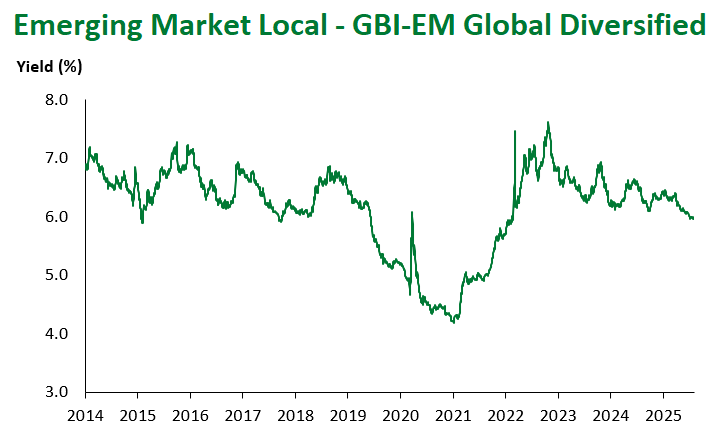
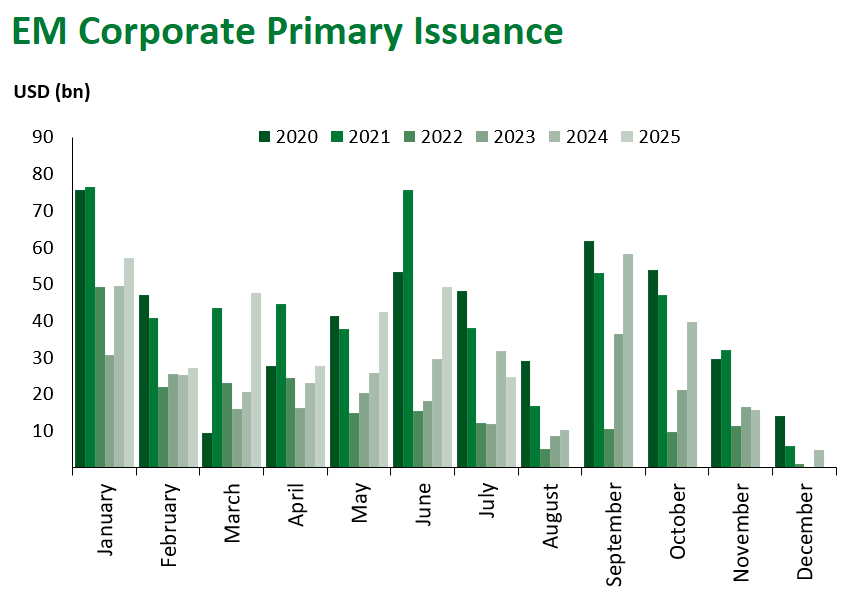
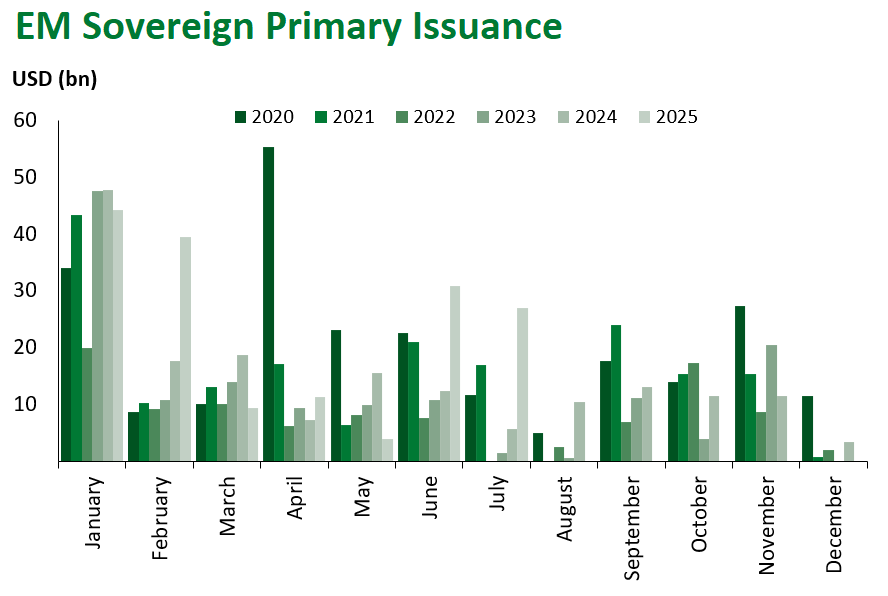
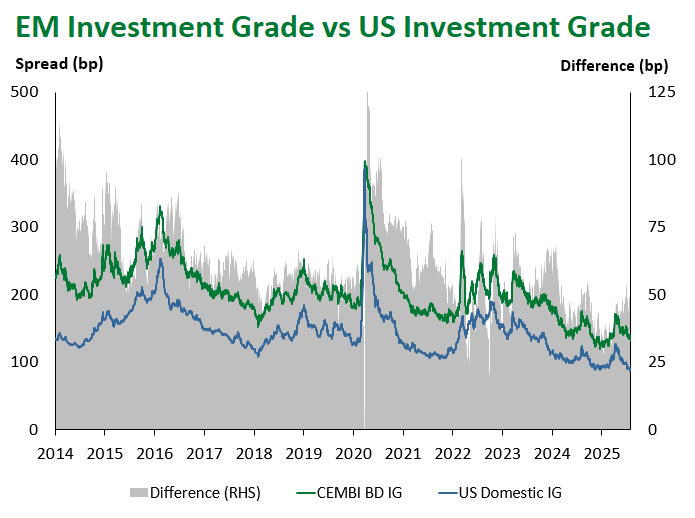

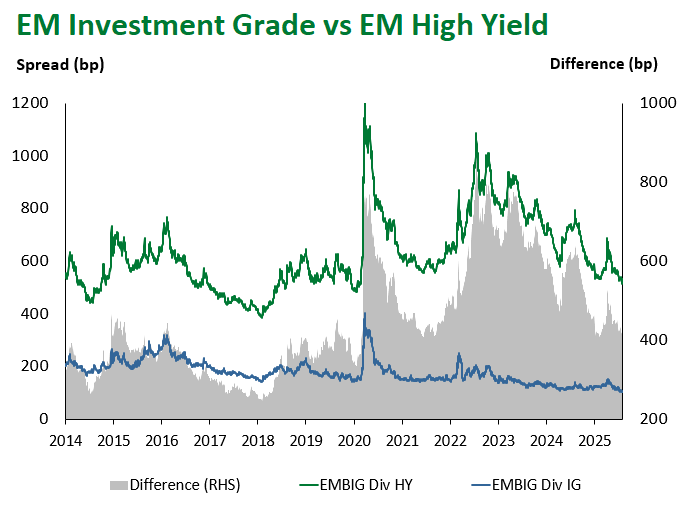
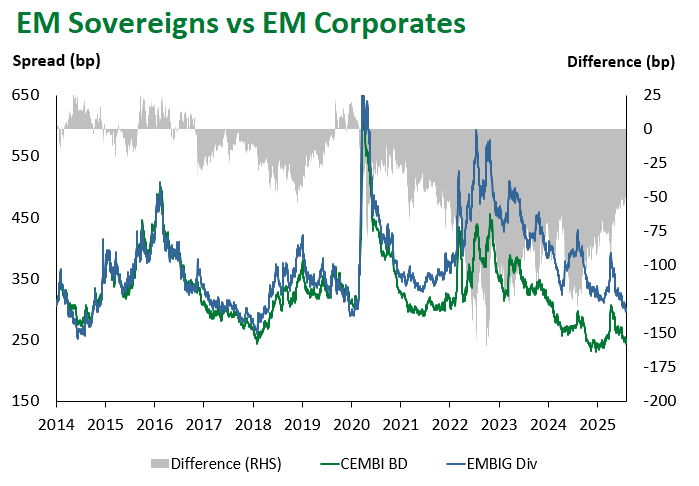
Emerging Markets Flows
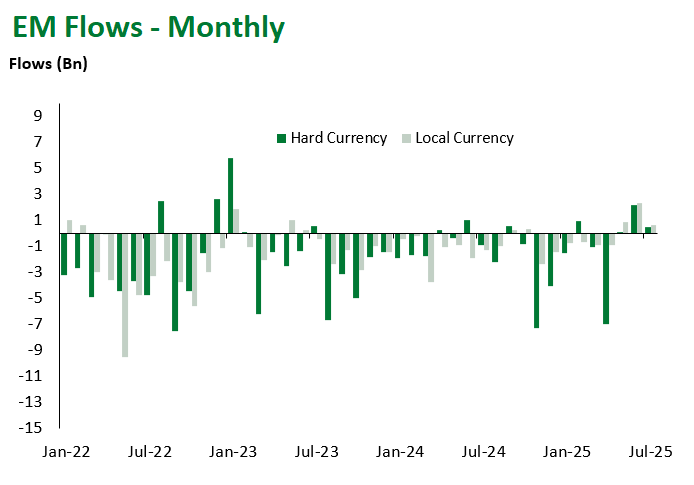
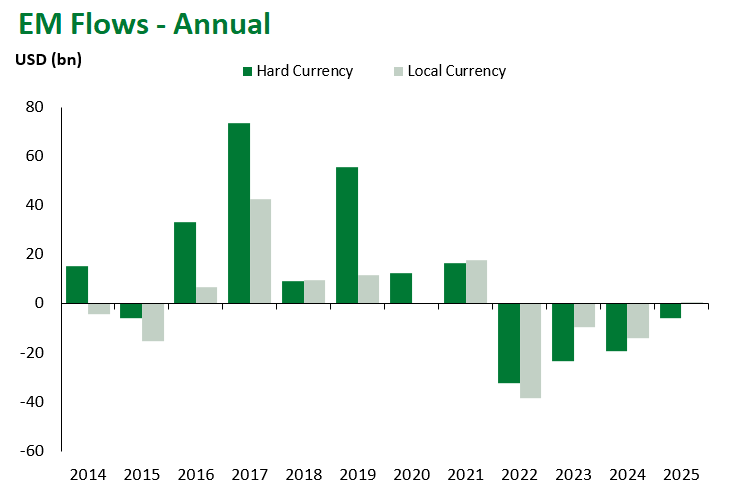
Source for graphs: Bloomberg, JPMorgan, Gramercy. As of August 1, 2025.
For questions, please contact:
Kathryn Exum, CFA ESG, Director, Co-Head of Sovereign Research, [email protected]
Petar Atanasov, Director, Co-Head of Sovereign Research, [email protected]
This document is for informational purposes only. The information presented is not intended to be relied upon as a forecast, research or investment advice, and is not a recommendation, offer or solicitation to buy or sell any securities or to adopt any investment strategy. Gramercy may have current investment positions in the securities or sovereigns mentioned above. The information and opinions contained in this paper are as of the date of initial publication, derived from proprietary and nonproprietary sources deemed by Gramercy to be reliable, are not necessarily all-inclusive and are not guaranteed as to accuracy. This paper may contain “forward-looking” information that is not purely historical in nature. Such information may include, among other things, projections and forecasts. There is no guarantee that any forecasts made will come to pass. Reliance upon information in this paper is at the sole discretion of the reader. You should not rely on this presentation as the basis upon which to make an investment decision. Investment involves risk. There can be no assurance that investment objectives will be achieved. Investors must be prepared to bear the risk of a total loss of their investment. These risks are often heightened for investments in emerging/developing markets or smaller capital markets. International investing involves risks, including risks related to foreign currency, limited liquidity, less government regulation, and the possibility of substantial volatility due to adverse political, economic or other developments. References to any indices are for informational and general comparative purposes only. The performance data of various indices mentioned in this update are updated and released on a periodic basis before finalization. The performance data of various indices presented herein was current as of the date of the presentation. Please refer to data returns of the separate indices if you desire additional or updated information. Indices are unmanaged, and their performance results do not reflect the impact of fees, expenses, or taxes that may be incurred through an investment with Gramercy. Returns for indices assume dividend reinvestment. An investment cannot be made directly in an index. Accordingly, comparing results shown to those of such indices may be of limited use. The information provided herein is neither tax nor legal advice. Investors should speak to their tax professional for specific information regarding their tax situation.
